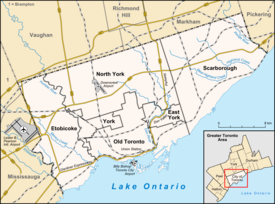Cabbagetown (Toronto)
| Cabbagetown | |
|---|---|
| Neighbourhood | |

Houses in Cabbagetown
|
|
| Location within Toronto | |
| Coordinates: 43°39′59″N 79°21′46″W / 43.6664°N 79.3629°WCoordinates: 43°39′59″N 79°21′46″W / 43.6664°N 79.3629°W | |
| Country |
|
| Province |
|
| City |
|
Cabbagetown is a neighbourhood in central Toronto, Ontario, Canada. Administratively, it is defined as part of the Cabbagetown-South St. Jamestown neighbourhood. It largely features semi-detached Victorian houses and is recognized as "the largest continuous area of preserved Victorian housing in all of North America", according to the Cabbagetown Preservation Association.
Cabbagetown's name derives from the Irish immigrants who moved to the neighbourhood beginning in the late 1840s, said to have been so poor that they grew cabbage in their front yards. Canadian writer Hugh Garner's novel, Cabbagetown, depicted life in the neighbourhood during the Great Depression.
The area today known as Cabbagetown was first known as the village of Don Vale, just outside Toronto. Before the 1850s it consisted of farmland dotted with cottages and vegetable plots. It grew up in the 1840s around the Winchester Street Bridge, which before the construction of the Prince Edward Viaduct was the main northern bridge over the Don River. This was near the site where Castle Frank Brook flowed in the Don River. By the bridge the Don Vale Tavern and Fox's Inn were established to cater to travellers. In 1850 the Toronto Necropolis was established in the area as the city's main cemetery.
In the late 19th century the area was absorbed into the city. It became home to the working class Irish inhabitants who were employed in the industries along the lake shore to the south in Corktown. Brick Victorian style houses were built throughout the area. The name Cabbagetown purportedly came from stories of new Irish immigrants digging up their front lawns and planting cabbage. In this era the Cabbagetown name most often applied to the area south of Gerrard Street, with the part to the north still being called Don Vale. It was a working-class neighbourhood, but reached its peak of prosperity just before the First World War, which is from when many of the brick homes in the area date.
...
Wikipedia

